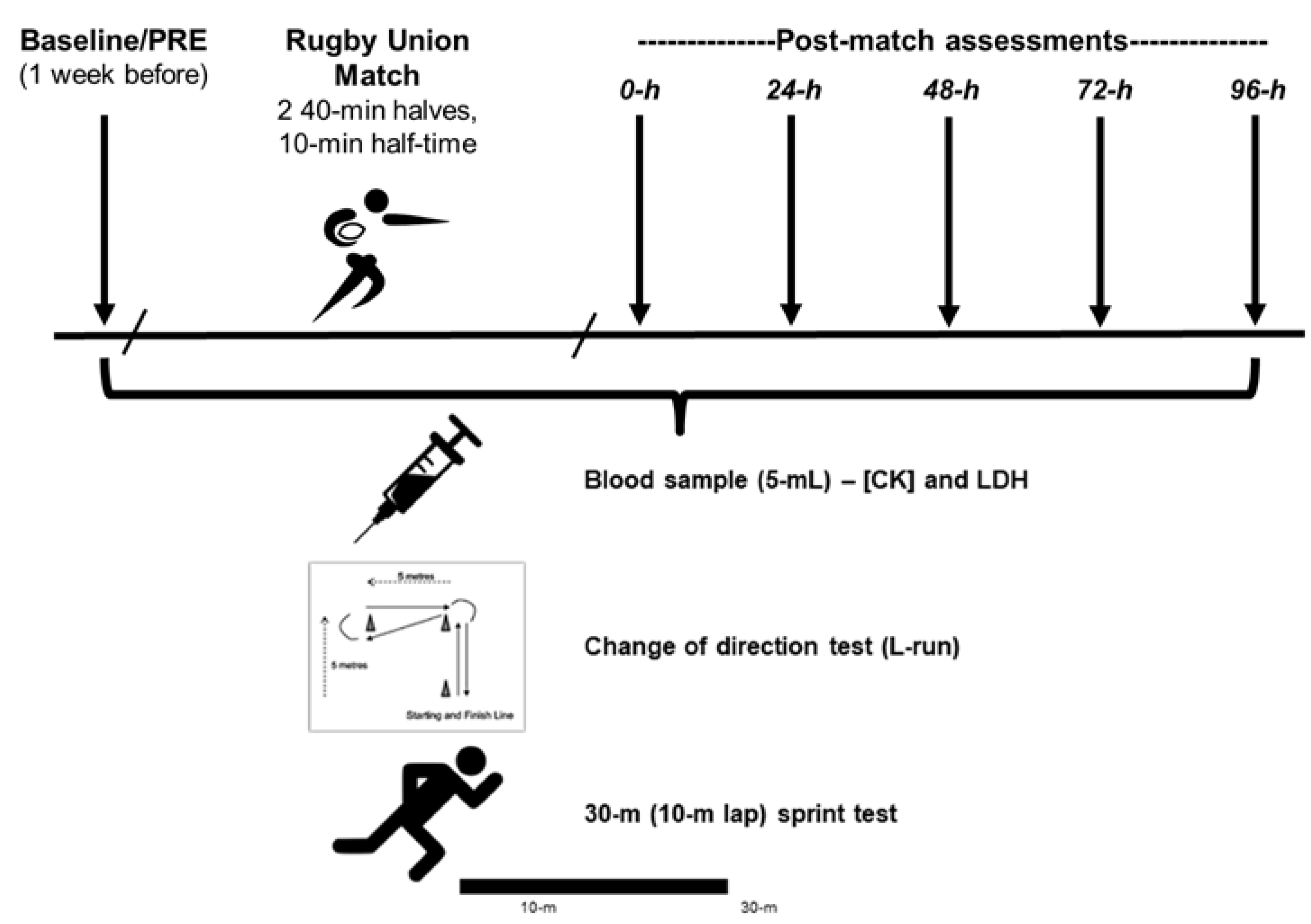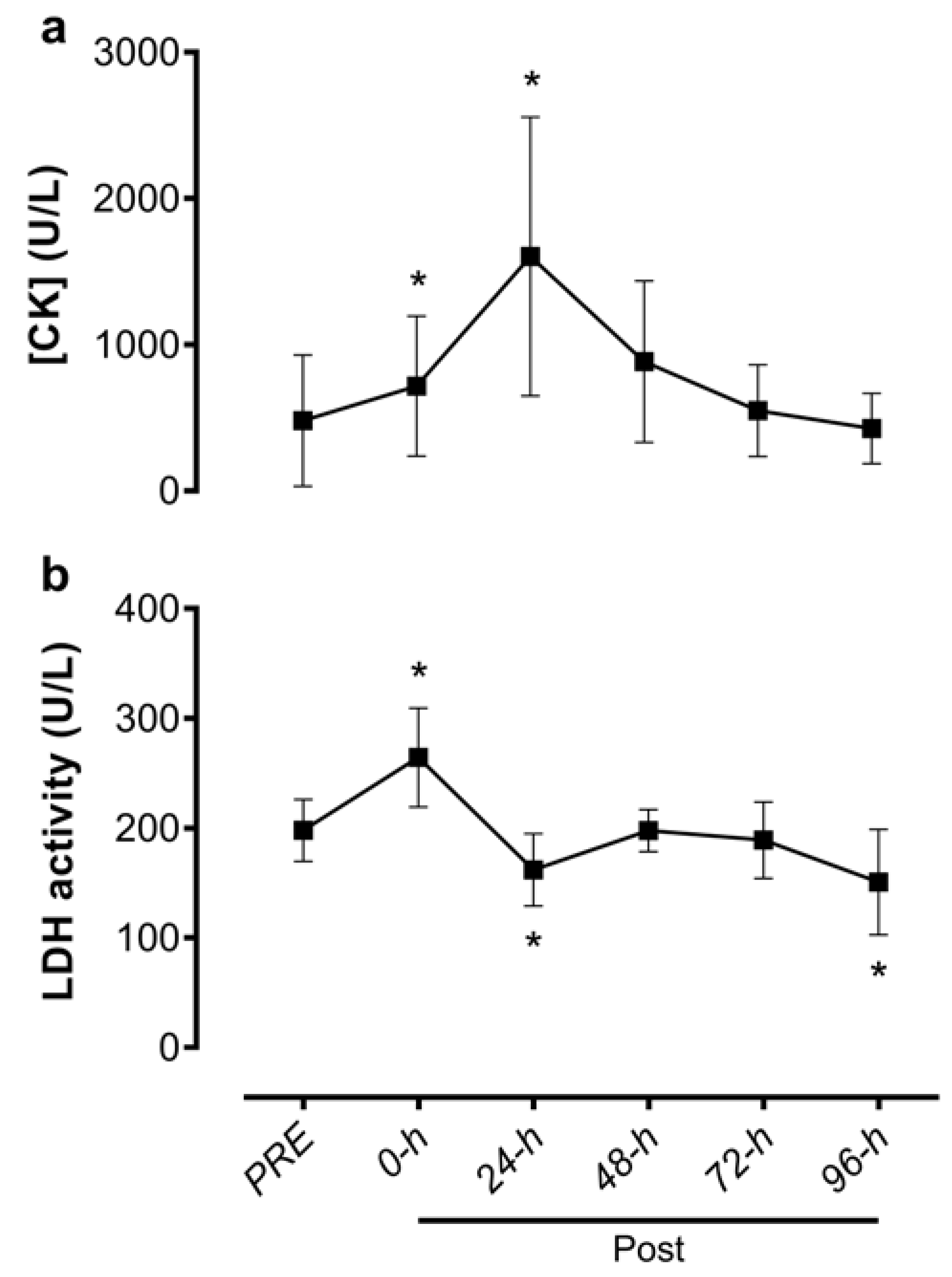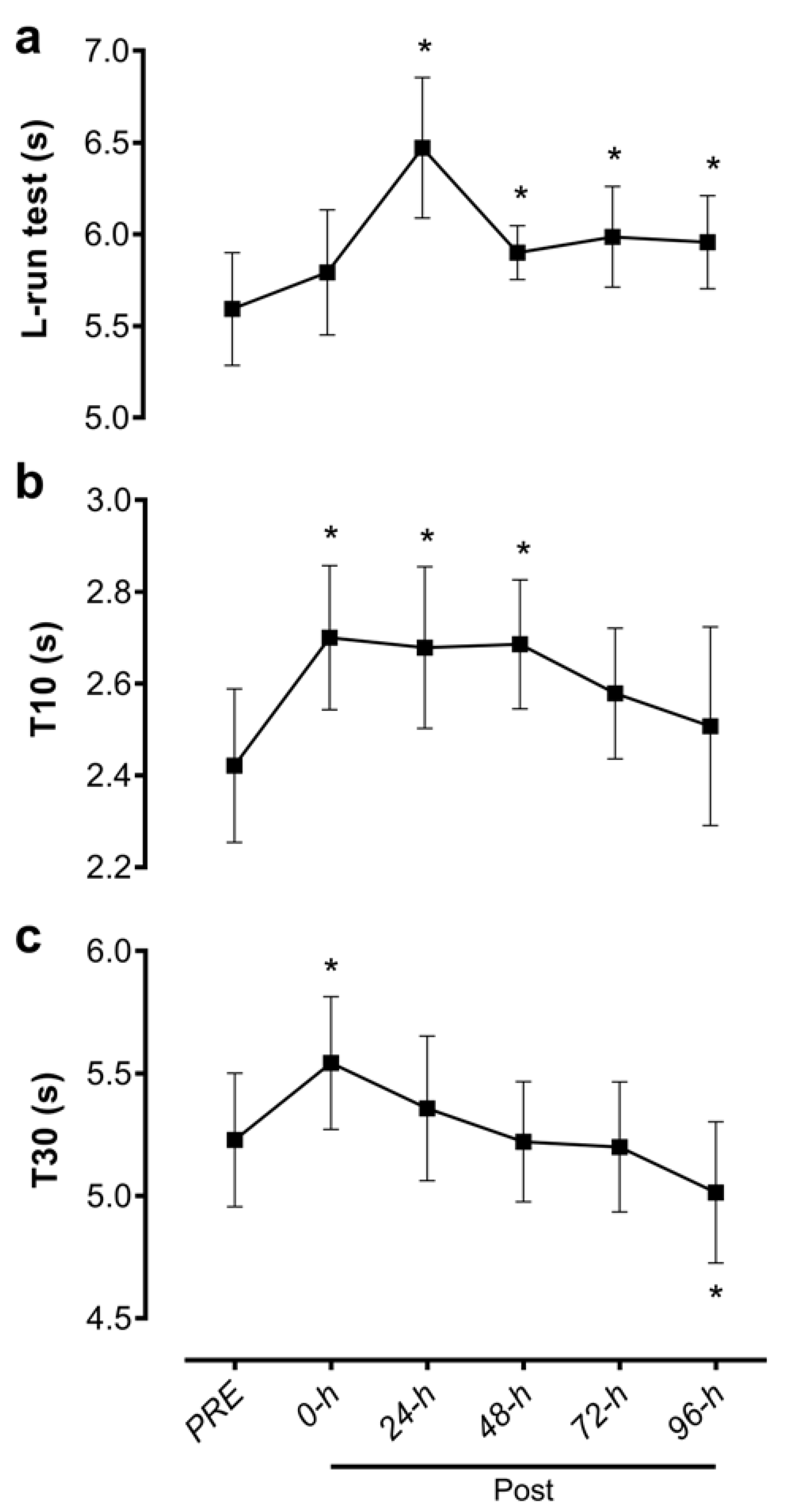Time Course of Recovery for Performance Attributes and Circulating Markers of Muscle Damage Following a Rugby Union Match in Amateur Athletes
Abstract
:1. Introduction
2. Materials and Methods
2.1. Participants
2.2. Procedures
2.2.1. Plasma Activity of Muscle Enzymes
2.2.2. L Run Test
2.2.3. 30-m Sprint Test (T10 and T30)
2.2.4. Rugby Union Match and Rate of Perceived Exertion
2.3. Statistical Analyses
3. Results
3.1. Rugby Union Match And Rating of Perceived Exertion
3.2. Plasma Activity of Muscle Enzymes—Creatine Kinase ([CK]) and Lactate Dehydrogenase (LDH)
3.3. L Run Test
3.4. Sprint Tests (T10 and T30)
4. Discussion
5. Conclusions
Author Contributions
Funding
Acknowledgments
Conflicts of Interest
References
- Gabbett, T.; King, T.; Jenkins, D. Applied physiology of rugby league. Sports Med. 2008, 38, 119–138. [Google Scholar] [CrossRef] [PubMed]
- Gabbett, T.; Kelly, J.; Sheppard, J. Speed, change of direction speed, and reactive agility of rugby league players. J. Strength Cond. Res. 2008, 22, 174–181. [Google Scholar] [CrossRef] [PubMed]
- Tavares, F.; Smith, T.B.; Driller, M. Fatigue and recovery in rugby: A review. Sports Med. 2017, 47, 1515–1530. [Google Scholar] [CrossRef] [PubMed]
- Suzuki, M.; Umeda, T.; Nakaji, S.; Shimoyama, T.; Mashiko, T.; Sugawara, K. Effect of incorporating low intensity exercise into the recovery period after a rugby match. Br. J. Sports Med. 2004, 38, 436–440. [Google Scholar] [CrossRef] [Green Version]
- Takarada, Y. Evaluation of muscle damage after a rugby match with special reference to tackle plays. Br. J. Sports Med. 2003, 37, 416–419. [Google Scholar] [CrossRef] [Green Version]
- McLellan, C.P.; Lovell, D.I.; Gass, G.C. Markers of postmatch fatigue in professional rugby league players. J. Strength Cond. Res. 2011, 25, 1030–1039. [Google Scholar] [CrossRef]
- Jones, M.R.; West, D.J.; Harrington, B.J.; Cook, C.J.; Bracken, R.M.; Shearer, D.A.; Kilduff, L.P. Match play performance characteristics that predict post-match creatine kinase responses in professional rugby union players. BMC Sports Sci. Med. Rehabil. 2014, 6, 38. [Google Scholar] [CrossRef] [Green Version]
- Friden, J.; Sjöström, M.; Ekblom, B. A morphological study of delayed muscle soreness. Experientia 1981, 37, 506–507. [Google Scholar] [CrossRef]
- West, D.J.; Cook, C.J.; Stokes, K.A.; Atkinson, P.; Drawer, S.; Bracken, R.M.; Kilduff, L.P. Profiling the time-course changes in neuromuscular function and muscle damage over two consecutive tournament stages in elite rugby sevens players. J. Sci. Med. Sport 2014, 17, 688–692. [Google Scholar] [CrossRef]
- Twist, C.; Highton, J. Monitoring fatigue and recovery in rugby league players. J. Sci. Med. Sport 2013, 8, 467–474. [Google Scholar] [CrossRef] [Green Version]
- Garcia, C.A.; da Mota, G.R.; Leicht, A.S.; Marocolo, M. Ischemic preconditioning and acute recovery of performance in rugby union players. Sports Med. Int. Open 2017, 1, E107–E112. [Google Scholar] [CrossRef] [PubMed] [Green Version]
- Garcia, C.A.; da Mota, G.R.; Marocolo, M. Cold water immersion is acutely detrimental but increases performance post-12 h in rugby players. Int. J. Sports Med. 2016, 37, 619–624. [Google Scholar] [CrossRef]
- Johnston, R.D.; Gabbett, T.J.; Jenkins, D.G.; Hulin, B.T. Influence of physical qualities on post-match fatigue in rugby league players. J. Sci. Med. Sport 2015, 18, 209–213. [Google Scholar] [CrossRef] [PubMed]
- Mota, G.R.; Rightmire, Z.B.; Martin, J.S.; McDonald, J.R.; Kavazis, A.N.; Pascoe, D.D.; Gladden, L.B. Ischemic preconditioning has no effect on maximal arm cycling exercise in women. Eur. J. Appl. Physiol. 2020, 120, 369–380. [Google Scholar] [CrossRef] [PubMed]
- Green, B.S.; Blake, C.; Caulfield, B.M. A valid field test protocol of linear speed and agility in rugby union. J. Strength Cond. Res. 2011, 25, 1256–1262. [Google Scholar] [CrossRef] [PubMed]
- Crewther, B.T.; Lowe, T.; Weatherby, R.P.; Gill, N.; Keogh, J. Neuromuscular performance of elite rugby union players and relationships with salivary hormones. J. Strength Cond. Res. 2009, 23, 2046–2053. [Google Scholar] [CrossRef]
- Deutsch, M.U.; Kearney, G.A.; Rehrer, N.J. Time-motion analysis of professional rugby union players during match-play. J. Sports Sci. 2007, 25, 461–472. [Google Scholar] [CrossRef]
- Gabbett, T.J. Science of rugby league football: A review. J. Sports Sci. 2005, 23, 961–976. [Google Scholar] [CrossRef]
- Borg, E.; Kaijser, L. A comparison between three rating scales for perceived exertion and two different work tests. Scand. J. Med. Sci. Sports 2006, 16, 57–69. [Google Scholar] [CrossRef]
- Arriel, R.A.; de Souza, H.L.R.; da Mota, G.R.; Marocolo, M. Declines in exercise performance are prevented 24 hours after post-exercise ischemic conditioning in amateur cyclists. PLoS ONE 2018, 13, e0207053. [Google Scholar] [CrossRef]
- Gimenes, S.V.; Marocolo, M.; Pavin, L.N.; Spigolon, L.M.P.; Barbosa Neto, O.; da Silva, B.V.C.; Duffield, R.; da Mota, G.R. Compression Stockings Used During Two Soccer Matches Improve Perceived Muscle Soreness and High-Intensity Performance. J. Strength Cond. Res. 2019. [Google Scholar] [CrossRef] [PubMed]
- Slimani, M.; Cheour, F.; Moalla, W.; Baker, J.S. Hormonal responses to a rugby match: A brief review. J. Sports Med. Phys. Fit. 2018, 58, 707–713. [Google Scholar] [CrossRef]
- Campbell, P.G.; Peake, J.M.; Minett, G.M. The specificity of rugby union training sessions in preparation for match demands. Int. J. Sports Physiol. Perform. 2018, 13, 496–503. [Google Scholar] [CrossRef] [PubMed] [Green Version]
- Lacome, M.; Carling, C.; Hager, J.P.; Dine, G.; Piscione, J. Workload, fatigue and muscle damage in an u20 rugby union team over an intensified international tournament. Int. J. Sports Physiol. Perform. 2018. Advance online publication. [Google Scholar] [CrossRef]
- Simim, M.A.; Bradley, P.S.; da Silva, B.V.; Mendes, E.L.; de Mello, M.T.; Marocolo, M.; da Mota, G.R. The quantification of game-induced muscle fatigue in amputee soccer players. J. Sports Med. Phys. Fit. 2017, 57, 766–772. [Google Scholar] [CrossRef]
- Montgomery, P.G.; Pyne, D.B.; Hopkins, W.G.; Dorman, J.C.; Cook, K.; Minahan, C.L. The effect of recovery strategies on physical performance and cumulative fatigue in competitive basketball. J. Sports Sci. 2008, 26, 1135–1145. [Google Scholar] [CrossRef]
- Katis, A.; Kellis, E. Effects of small-sided games on physical conditioning and performance in young soccer players. J. Sports Sci. Med. 2009, 8, 374–380. [Google Scholar]
- Zemková, E.; Hamar, D. The effect of soccer match induced fatigue on neuromuscular performance. Kinesiology 2009, 41, 195–202. [Google Scholar]
- Pavin, L.N.; Leicht, A.S.; Gimenes, S.V.; da Silva, B.V.C.; Simim, M.A.M.; Marocolo, M.; da Mota, G.R. Can compression stockings reduce the degree of soccer match-induced fatigue in females? Res. Sports Med. 2019, 27, 351–364. [Google Scholar] [CrossRef]
- Brancaccio, P.; Maffulli, N.; Limongelli, F.M. Creatine kinase monitoring in sport medicine. Br. Med. Bull. 2007, 81–82, 209–230. [Google Scholar] [CrossRef]
- Bieuzen, F.; Pournot, H.; Roulland, R.; Hausswirth, C. Recovery after high-intensity intermittent exercise in elite soccer players using VEINOPLUS sport technology for blood-flow stimulation. J. Athl. Train. 2012, 47, 498–506. [Google Scholar] [CrossRef] [PubMed] [Green Version]



© 2020 by the authors. Licensee MDPI, Basel, Switzerland. This article is an open access article distributed under the terms and conditions of the Creative Commons Attribution (CC BY) license (http://creativecommons.org/licenses/by/4.0/).
Share and Cite
da Silva, B.V.C.; Simim, M.A.d.M.; da Silva, R.B.; Mendes, E.L.; Ide, B.N.; Marocolo, M.; Martin, J.S.; Mota, G.R. Time Course of Recovery for Performance Attributes and Circulating Markers of Muscle Damage Following a Rugby Union Match in Amateur Athletes. Sports 2020, 8, 64. https://doi.org/10.3390/sports8050064
da Silva BVC, Simim MAdM, da Silva RB, Mendes EL, Ide BN, Marocolo M, Martin JS, Mota GR. Time Course of Recovery for Performance Attributes and Circulating Markers of Muscle Damage Following a Rugby Union Match in Amateur Athletes. Sports. 2020; 8(5):64. https://doi.org/10.3390/sports8050064
Chicago/Turabian Styleda Silva, Bruno Victor Corrêa, Mário Antônio de Moura Simim, Rodrigo Barboza da Silva, Edmar Lacerda Mendes, Bernardo Neme Ide, Moacir Marocolo, Jeffrey S. Martin, and Gustavo R. Mota. 2020. "Time Course of Recovery for Performance Attributes and Circulating Markers of Muscle Damage Following a Rugby Union Match in Amateur Athletes" Sports 8, no. 5: 64. https://doi.org/10.3390/sports8050064
APA Styleda Silva, B. V. C., Simim, M. A. d. M., da Silva, R. B., Mendes, E. L., Ide, B. N., Marocolo, M., Martin, J. S., & Mota, G. R. (2020). Time Course of Recovery for Performance Attributes and Circulating Markers of Muscle Damage Following a Rugby Union Match in Amateur Athletes. Sports, 8(5), 64. https://doi.org/10.3390/sports8050064







